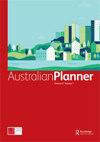Tiny House – when size matters
IF 1.5
Q2 Social Sciences
引用次数: 1
Abstract
ABSTRACT At 231 m2, Australia has the largest average house size in the world. For many reasons, this is unsustainable. Tiny Houses (dwellings less than 37.2 m2) are at the opposite end of the spectrum of house size. It is well understood that smaller houses use less materials than larger houses, less energy in their construction and use, and it can be argued that they produce less waste. Thus, a Tiny House is generally seen as being more sustainable than the average Australian house. However, the exaggerated reduction of size and function in some Tiny Houses means that they can end up being unliveable for many people in Australia. In contrast, Tiny Houses are the norm in many other countries. This suggests that there are many elements of choice in Australian housing that are considered a necessity. This paper investigates house size and elements of necessity and choice. It argues that to be sustainable we need to reconsider housing options. Tiny Houses could become a much larger proportion of housing stock, but the definition, understanding, design and production of the Tiny House needs to move beyond just achieving a prescribed floor area, to including the functional and amenity needs of the household occupants.小房子——当尺寸很重要的时候
澳大利亚的平均房屋面积为231平方米,是世界上最大的。出于许多原因,这是不可持续的。小房子(小于37.2平方米的住宅)是房子大小的另一端。众所周知,小房子比大房子使用更少的材料,在建造和使用中使用更少的能源,而且可以认为它们产生的废物更少。因此,微型住宅通常被认为比普通的澳大利亚住宅更具可持续性。然而,一些小房子的尺寸和功能的夸张缩小意味着它们最终可能对许多澳大利亚人来说是不适合居住的。相比之下,小房子在许多其他国家都是常态。这表明,在澳大利亚住房中有许多选择因素被认为是必要的。本文调查了房屋的大小以及必要性和选择的要素。报告认为,为了可持续发展,我们需要重新考虑住房选择。微型住宅可能会在住房存量中占据更大的比例,但微型住宅的定义、理解、设计和生产需要的不仅仅是达到规定的建筑面积,还要包括家庭居住者的功能和舒适需求。
本文章由计算机程序翻译,如有差异,请以英文原文为准。
求助全文
约1分钟内获得全文
求助全文

 求助内容:
求助内容: 应助结果提醒方式:
应助结果提醒方式:


